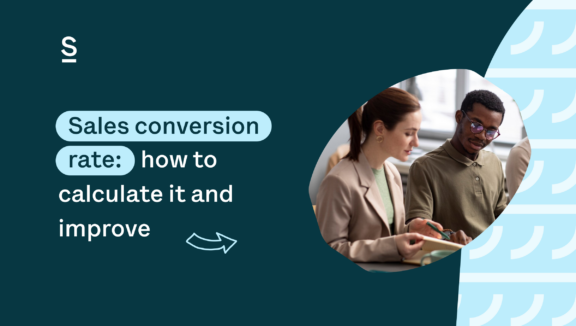Sales conversion rate: How to calculate it (and improve it!)

In the dynamic realm of sales, the ability to convert leads into paying customers is the lifeblood of any business. Understanding and optimizing your sales conversion rate can significantly impact your bottom line, driving revenue growth and success. It’s time to delve into the intricacies of sales conversion rates, go through the process of calculating them accurately, and learn valuable insights on how to improve and skyrocket your conversion rate.
What is a Conversion Rate in Sales?
Before we explore the art of calculating and improving sales conversion rates, it’s vital to establish a solid foundation by understanding what a conversion rate represents in sales. Simply put, a conversion rate is the percentage of leads or prospects who take a desired action, such as making a purchase, signing up for a free trial, or requesting more information. This powerful metric serves as a barometer for the effectiveness of your sales efforts and provides invaluable feedback to refine your strategies.
Calculating Sales Conversion Rate
Define What You Consider a “Conversion”
To accurately calculate your sales conversion rate, it’s crucial to define precisely what action you consider a “conversion.” This definition may vary depending on your unique business goals and objectives. For example, if you operate an e-commerce store, a conversion might refer to a completed purchase. Conversely, if you’re in the software-as-a-service (SaaS) industry, it could be a user signing up for a free trial.
Calculate Your Sales Conversion Rate
Calculating your sales conversion rate involves dividing the number of conversions by the total number of leads or prospects. For instance, if you had 100 leads and 10 of them made a purchase, your conversion rate would be 10%. This fundamental calculation lays the groundwork for evaluating and optimizing your sales performance.
Conversions / leads or prospects = conversion rate
What is a Good Conversion Rate in Sales?
- The answer to what constitutes a good conversion rate is multifaceted and depends on several factors, including your industry, product or service offering, and the specific stage of the sales funnel being measured. What might be considered a good conversion rate in one industry may not hold true for another.
- On average, a good conversion rate in sales falls between 2% to 5%. In practical terms, this means that out of 100 leads, you can expect 2 to 5 of them to convert into paying customers. However, it’s important to note that this benchmark serves as a starting point and should be evaluated in the context of your business.
- Moreover, it’s essential to consider the type of conversion rate you’re analyzing. For instance, if you’re evaluating the conversion rate of qualified leads to customers, a good rate can range from 20% to 30%. In other words, out of 10 qualified leads, you can expect 2 to 3 of them to become paying customers.
- To determine what constitutes a good conversion rate for your specific business, it’s crucial to track your conversion rates consistently and compare them against industry benchmarks and your own historical performance. This analysis allows you to identify trends, uncover opportunities for improvement, and adjust your strategies accordingly.
Improving Sales Conversion Rate
- Qualify Your Leads: One of the most effective ways to improve your sales conversion rate is by focusing on lead qualification. By identifying and targeting high-quality leads, you can increase the likelihood of conversion. Develop clear criteria for lead qualification based on factors such as demographics, buying intent, and fit with your product or service. This strategic approach enables you to concentrate your efforts on leads with the highest potential to convert, resulting in a higher conversion rate and a more efficient sales process.
- Personalize Your Sales Pitch: To maximize your conversion rate, tailor your sales pitch to each prospect. Take the time to deeply understand their pain points, needs, and objectives. Craft a personalized approach that highlights how your product or service can specifically solve their challenges and drive desirable outcomes. By demonstrating an intimate understanding of their unique circumstances, you build trust and significantly increase the likelihood of conversion. You can also personalize your outreach by using a tool like Surfe to send and track the performance of message templates on LinkedIn.
- Provide Compelling Social Proof: In today’s world of abundant choices, prospects seek reassurance before making a purchasing decision. Incorporating customer testimonials, case studies, and other forms of social proof into your sales process can be a game-changer. These elements play a pivotal role in building credibility and trust. By showcasing successful outcomes and satisfied customers, you instill confidence in your prospects and significantly boost your conversion rate. Encourage your happy customers to share their experiences and leverage their stories to inspire trust and confidence in potential buyers. Social proof will also fit perfectly into your social-selling strategy.
- Simplify and Optimize the Buying Process: A convoluted and cumbersome buying process can act as a significant barrier to conversion. Streamline the purchasing journey by minimizing the number of steps required and providing clear and concise instructions. Optimize your website’s user experience, streamline checkout processes, and eliminate unnecessary form fields. Additionally, ensure that your messaging is consistent across different touchpoints and aligns with the prospect’s expectations. A simplified and frictionless buying process reduces barriers and empowers prospects to convert with ease.
- Implement a Strategic Follow-Up System: Persistence pays off in sales. Research indicates that people require multiple touchpoints before they are ready to convert. Implement a robust follow-up strategy that includes nurturing leads through emails, phone calls, or personalized content. By staying top-of-mind and providing valuable information and resources, you increase the chances of converting leads who may not have been ready initially. Be attentive, responsive, and consistently provide value throughout the buyer’s journey.
In the fiercely competitive landscape of sales, optimizing your conversion rate is paramount for achieving business success. While a good conversion rate varies across industries and circumstances, consistently tracking and comparing your rates will help you identify areas for improvement. By qualifying your leads, personalizing your sales pitch, providing compelling social proof, simplifying and optimizing the buying process, and implementing a strategic follow-up system, you can significantly boost your conversion rate and propel your business to new heights.
Remember, the power of conversion lies in understanding your customers, addressing their needs, and providing exceptional value. Embrace these proven strategies, adapt them to your unique business context, and unleash the full potential of your sales conversion rate. In this era of exponential growth and innovation, every incremental percentage point gained can make a substantial difference to your business’s growth, profitability, and competitive advantage. Now is the time to optimize, refine, and achieve sales conversion greatness. Your customers are waiting, and your success story awaits!

Increase your sales conversion rate with personalized outreach
You can implement personalized outreach quickly and easily with Surfe’s message templates. Never copy and paste a message again with embedded message templates and determine which templates are performing with our analytics.


